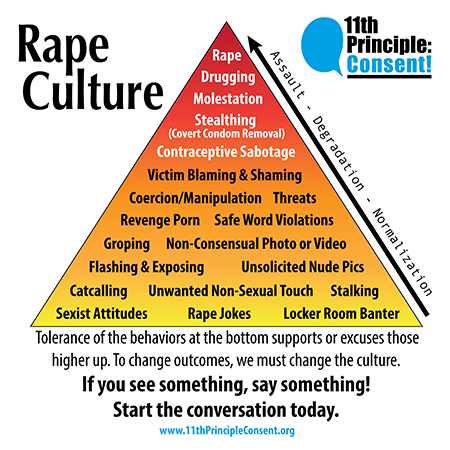Interpersonal Violence: General Information
Sexual Violence
 Sexual violence is often used as a broad term that includes sexual assault, sexual harassment, stalking, sexual exploitation, other unwanted sexual contact, and verbal expressions of a sexual nature that contribute to others feeling unsafe. At the core, sexual violence occurs when an individual is forced, coerced, or manipulated into unwanted sexual activity without their proper consent. For more information about sexual violence under Rutgers policy, visit the Title IX Policy webpage.
Sexual violence is often used as a broad term that includes sexual assault, sexual harassment, stalking, sexual exploitation, other unwanted sexual contact, and verbal expressions of a sexual nature that contribute to others feeling unsafe. At the core, sexual violence occurs when an individual is forced, coerced, or manipulated into unwanted sexual activity without their proper consent. For more information about sexual violence under Rutgers policy, visit the Title IX Policy webpage.
Each victim/survivor will react to this form of violence in their own unique way. Some may discuss what happened with others immediately, some may take a long time to share their story, and others may never disclose what happened to them. The reaction a victim/survivor gets when they do share their story can greatly impact if they will access resources or experience retraumatization.
Sexual violence is not only about control and/or sex at the individual level, but also is a part of the larger culture that uses violence as a means to continue disparities in power rooted in oppression. 1
Sexual violence happens to people of all ages, races, genders, sexual orientations, abilities, professions, incomes, cultures, and religions.
Stalking and Harassment
Stalking is a pattern of behavior that leaves people feeling afraid, harassed, and/or in danger. Stalking presents in different ways but often includes repeated contact. Examples of stalking can include: showing up at places without invite; sending repeated mail, email, texts or pictures; calling frequently; tracking or contacting through social media; damaging property intentionally; talking about the victim to others; threatening harm to self or others; and other actions that involve unwanted contact or fear-inducing behavior.
Those that are being stalked can create a support system to notify when they are afraid, speak to professionals about rights to protection, document all incidents of stalking behavior, develop a safety plan for situations that feel risky, and reach out for support services.
Sexual harassment includes behavior like unwanted sexual advances, requests for sexual favors, and physical harassment of a sexual nature. It also includes verbal expressions such as lewd comments, explicit gestures and jokes, distributing of offensive materials, and other gender-based statements. With sexual harassment, the impact is more important than the intent. Sexual harassment can be prevented by creating a culture of respect and encouraging others to speak up when harassing behavior occurs.
Dating Violence
Dating violence can also be referred to as relationship violence, intimate partner violence, or domestic violence. At the basic level, dating violence occurs within an intimate situation where one person is using a pattern of controlling or abusive behavior to maintain the power in that relationship.
Most people think of physical and sexual assault when they think of dating violence. But there are a range of behaviors that can occur within a dating violence situation. These include using intimidation and threats, using isolation to control where a person goes and who a person interacts with, using emotional abuse to make that person feel bad about themselves or feel “crazy”, using economic abuse by limiting access to funds and resources, and using digital or cyber means to track and control connections online.
